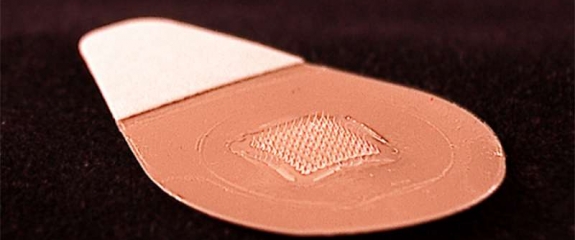A 100 micro-needle patch promises painless jabs

Not everyonelikes injections. Here is an alternative. A simple to apply patch about the size of a thumbprint that contains 100 tiny needles. Still not feeling it? The tiny needles are 650 micrometers (or about 0.03 inches) long and can be used to administer a variety of treatments. The patch is applied to the skin for about 20 minutes before peeling them off - when they can be safely thrown in the bin. When used in a recent clinical study, most recipeints (48 of 50) said that the patch didn't hurt at all. Researchers found that the study participants preferred the patch to getting a flu jab. This finding may have important consequences, not enough people get their flu vaccine each year. This failure is believed to be one of the reasons that around 48,000 people die prematurly in U.S. annually (The Lancet). It is hoped that because the microneedle patch is painless and easy to use it will encourage more people to take up the vaccine.
A small phase I clinical trial compared how the dissolvable microneedle patch containing flu vaccine performed versus a traditional flu shot. The researchers found that the microneedle patch was safe and led to a good immune response in the study participants, suggesting that the vaccine was working. Larger trials are now needed to confirm the utility of the patch. However, it was found that as the patch uses a dried version of the vaccine, it doesn't need to be refrigerated, and it was shown to be stable in temperatures of up to 40 degrees Celsius (104 degrees Fahrenheit) for up to a year, according to the study. You can even apply the patch yourself. Not surprisingly, the injection was more likely to cause pain whereas the patch was more likely to cause itching and redness.
Transdermal patches are an excellent means of delivering drugs but they only work for a small subset of drugs that can be absorbed through the skin. The tough-to-penetrate (for drugs) stratum corneum is only about 10 or 20 micrometers thick — thinner than a human hair. In principle, inch-long hypodermic needles are therefore not necessary to puncture the barrier.


